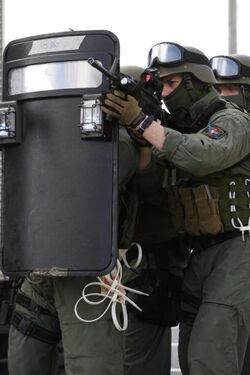Engineering:Ballistic shield
Ballistic shields (also called tactical shields) are protection devices deployed by police and military forces that are designed to stop or deflect bullets and other projectiles fired at their carrier. Ballistic shields will also protect from less serious threats such as thrown items, though they are typically used in situations where riot shields would not offer adequate protection.[1]
Background
Shields small enough to be carried by a single person may be termed "personal shields", and may be carried in police cars in the United States as standard equipment. Whether or not a shield is used will depend on both policy and the individual situation. It may be the policy of a police force to use shields only in defensive situations, such as establishing a perimeter and waiting for reinforcements, while others may permit their usage in offensive situations, such as vehicle stops that are considered high risk or approaching a suspect deemed to be dangerous.[2]
Recommended features of ballistic shields for police include a carrying system that allows it to be held long-term without fatigue, and the ability to both reload a handgun while holding the shield and also fire it accurately with one hand. The carriage of a ballistic shield in one hand will limit both the types of firearms that can used with the other hand as well as certain methods of shooting.[2]
Composition
Ballistic shields can be made out of materials such as UHMWPE or pre-preg aramid fibres. They may have features such as clear armored viewing ports, ambidextrous handles and spotlights for use at night, and may be either handheld or mounted on wheel-based frames. They vary in size, with some being designed to protect only the upper torso and others designed to protect the whole body.[1] Unlike a ballistic vest, projectiles successfully stopped by a ballistic shield will not transfer trauma or pain to the bearer, as they are designed to not be in direct contact with the body.[2]
See also
References
- ↑ 1.0 1.1 Bhatnagar, Ashok (2016). Lightweight Ballistic Composites: Military and Law-Enforcement Applications. Woodhead Publishing. p. 214. ISBN 978-0081004258. https://books.google.com/books?id=qZPBCQAAQBAJ&pg=PA214.
- ↑ 2.0 2.1 2.2 Armellino, Rick (March 9, 2010). "How to buy personal shields". PoliceOne. Archived from the original on 2014-06-19. https://archive.today/20140619082630/http://www.policeone.com/police-products/personal-shields/articles/2016145-How-to-buy-personal-shields/.


